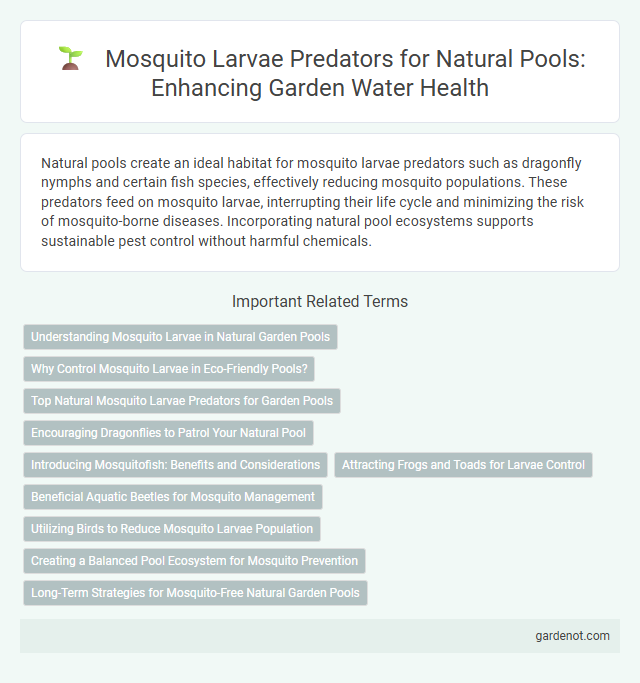Natural pools create an ideal habitat for mosquito larvae predators such as dragonfly nymphs and certain fish species, effectively reducing mosquito populations. These predators feed on mosquito larvae, interrupting their life cycle and minimizing the risk of mosquito-borne diseases. Incorporating natural pool ecosystems supports sustainable pest control without harmful chemicals.
Understanding Mosquito Larvae in Natural Garden Pools
Mosquito larvae thrive in stagnant water within natural garden pools, posing risks of increased mosquito populations and potential disease transmission. Effective mosquito larvae predators such as Gambusia affinis (mosquito fish), dragonfly nymphs, and certain species of aquatic beetles serve as biological control agents by feeding on larvae and reducing larval density. Incorporating these natural predators into garden pool ecosystems enhances biodiversity and minimizes reliance on chemical insecticides, promoting a balanced and sustainable aquatic environment.
Why Control Mosquito Larvae in Eco-Friendly Pools?
Controlling mosquito larvae in eco-friendly natural pools is essential to prevent the spread of diseases such as malaria and West Nile virus, while maintaining a balanced aquatic ecosystem. Predators like dragonfly nymphs and certain fish species naturally reduce mosquito populations without harmful chemicals, promoting biodiversity and water quality. Effective larval control ensures a safe, healthy environment for swimmers and local wildlife, enhancing the sustainability of the natural pool.
Top Natural Mosquito Larvae Predators for Garden Pools
Dragonfly larvae, known as aquatic nymphs, serve as top natural mosquito larvae predators in garden pools by voraciously consuming mosquito larvae before they mature. Gambusia affinis, commonly called mosquito fish, are widely introduced in natural pools for their efficiency in drastically reducing mosquito populations. Predatory beetle larvae such as those from the Dytiscidae family also contribute significantly to controlling mosquito larvae, maintaining a balanced ecosystem in garden pools.
Encouraging Dragonflies to Patrol Your Natural Pool
Dragonflies serve as effective mosquito larvae predators, significantly reducing mosquito populations around natural pools. Encouraging dragonflies by planting native aquatic vegetation and providing sunlit perching spots creates an ideal habitat for their breeding and hunting activities. These predatory insects naturally control larvae, promoting a balanced ecosystem and minimizing the need for chemical interventions.
Introducing Mosquitofish: Benefits and Considerations
Mosquitofish (Gambusia affinis) serve as effective natural predators of mosquito larvae, helping to maintain balanced ecosystems in natural pools by reducing mosquito populations without the use of chemicals. Their introduction benefits natural pools by controlling pest insects, enhancing water quality, and supporting biodiversity. However, careful management is required to prevent ecological disruption, as mosquitofish may compete with native species or become invasive in certain environments.
Attracting Frogs and Toads for Larvae Control
Frogs and toads serve as effective natural predators for mosquito larvae in natural pools, helping maintain ecological balance. Creating suitable habitats such as shallow, vegetated areas with ample hiding spots attracts these amphibians and encourages their breeding. Promoting native plant growth around the pool enhances shelter and food availability, supporting populations of frogs and toads essential for biological mosquito control.
Beneficial Aquatic Beetles for Mosquito Management
Beneficial aquatic beetles, such as diving beetles (Dytiscidae) and whirligig beetles (Gyrinidae), serve as effective natural predators of mosquito larvae in natural pools. These beetles contribute to mosquito management by feeding on larvae, thus reducing mosquito populations without chemical intervention. Incorporating habitats that support aquatic beetle populations enhances biological control and promotes ecological balance in natural pool environments.
Utilizing Birds to Reduce Mosquito Larvae Population
Utilizing birds such as purple martins and tree swallows in natural pool environments effectively reduces mosquito larvae populations by preying on them during their aquatic stages. These insectivorous birds contribute to sustainable mosquito control without the need for chemical interventions, promoting ecological balance. Encouraging bird habitats around natural pools enhances biodiversity while minimizing mosquito-borne disease risks.
Creating a Balanced Pool Ecosystem for Mosquito Prevention
Introducing natural mosquito larvae predators such as dragonfly nymphs and mosquito fish enhances the biological control within a natural pool, reducing larvae populations effectively. Maintaining a balanced aquatic ecosystem with diverse predator species supports sustainable mosquito prevention by limiting breeding habitats. Regular monitoring and promoting native predatory organisms ensure long-term health and ecological stability of the pool environment.
Long-Term Strategies for Mosquito-Free Natural Garden Pools
Introducing native fish species such as Gambusia affinis effectively controls mosquito larvae in natural garden pools by reducing their population over time. Incorporating aquatic plants like water lilies and duckweed creates a balanced ecosystem that supports predator insects and amphibians, which naturally prey on mosquito larvae. Regular monitoring and maintaining water quality ensures a sustainable, mosquito-free environment without relying on chemical interventions.
Mosquito larvae predator Infographic

 gardenot.com
gardenot.com